![]()
![]()
![]()
Use LEFT and RIGHT arrow keys to navigate between flashcards;
Use UP and DOWN arrow keys to flip the card;
H to show hint;
A reads text to speech;
19 Cards in this Set
- Front
- Back
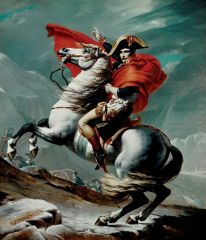
|
Jacques-Louise David
Napoleon Crossing the Saint-Bernard Pass 1800-1801 Neoclassical Propagandist: Dramatic lighting, tiny other ppl, proportion to the horse |
|
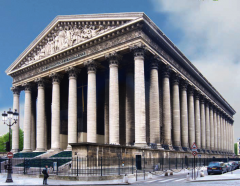
|
Pierre Vignon
La Madeleine 1807-1842 Neoclassical architecture "temple of glory" for armies, to link Napoleon to Roman empire |
|
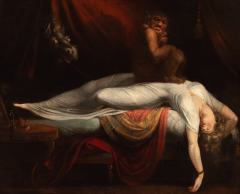
|
Henry Fuseli
The Nightmare 1781 Romantic: emphasis on feeling over reason Incubus sits on torso, eye-less horse peaks in Dark terrain of human subconscious |
|

|
Francisco Goya
Third of May, 1808 1814-1815 Historical, Romantic Goya encouraged empathy for massacred peasants Horrified expressions, endowing humanity vs. anonymous French soldiers Cruciform gesture of main figure |
|
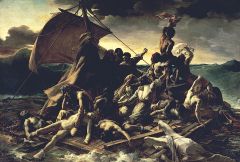
|
Theodore Gericault
Raft of the Medusa 1818-1819 Historical, Romantic Jumble of writhing bodies in every attitude of suffering Grandeur of Neoclassical history painting Artist's commentary on practice of slavery, criticism of French gov't |
|
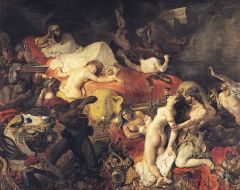
|
Eugene Delacroix
Death of Sardanapalus 1827 Romantic Inspired by poem Richly colored and emotionally charged canvas Filled with exotic, erotic figures |
|
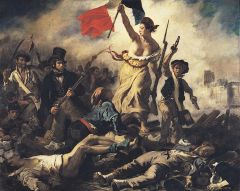
|
Eugene Delacroix
Liberty Leading the People 1830 Romantic Balanced mix of history (actual landmark) and poetic allegory Allegorical personification of Liberty Ex-slave on left |
|

|
John Constable
The Haywain 1821 Romantic Nostalgic view of disappearing English countryside Muted greens, delicacy of brushstrokes complement tranquil scene Figures blend in, representing oneness w/ nature |
|
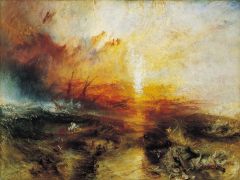
|
J.M.W. Turner
The Slav Ship 1840 Innovative style: use of emotive power of color Released it from defining outlines to express forces of nature and painter's emotional response to them Reinforces feeling of sublime w/ immense power of nature over humans |
|
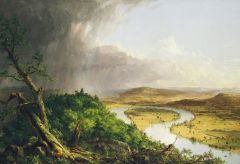
|
Thomas Cole
The Oxbow 1836 Romantic landscape Expansive wilderness incorp. romantically appealing moods and reflections Cole divided his canvas into dark wilderness on left and sunlit civilization on right |
|
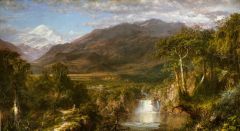
|
Frederic Edwin Church
The Heart of the Andes 1859 Romantic landscape Very realistic, no moralizing narrative Depicts idealized landscape Painstakingly detailed, accurate specifics (but not setting) |
|
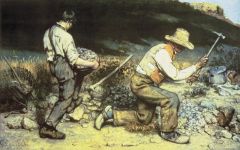
|
Gustave Courbet
The Stone Breakers, 1849 Realistic: championing everyday life Palette of dirty browns and grays Conveyed dreary and dismal nature of menial labor in mid-century France |
|
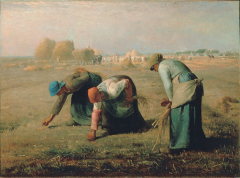
|
Jean-Francois Millet
The Gleaners 1857 Realistic French country life 3 Impoverished women gathering the scraps left in the field after harvest Backbreaking task of gleaning |
|
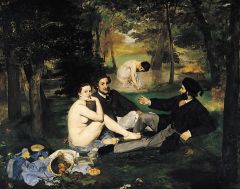
|
Edouard Manet
Le Dejeuner sur L'Herb (Luncheon on the Grass) 1863 Realistic? Moves away from illusionism Used colors to flatten form and draw attention to painting surface Abrupt changes in tonality |
|
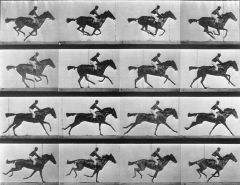
|
Eadweard Muybridge
Horse Galloping 1878 Realistic(?) photography Successive stages of motion, details too quick for human eye to capture Modern cinema owes him big time |
|

|
Georges Seurat
A Sunday on La Grande Jatte 1884-1886 Post-Impressionist Pointilism: dividing colors into components, applying colors to canvas in tiny dots Forms comprehensible only from a distance |
|
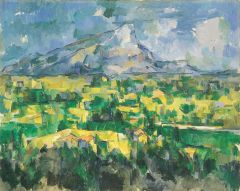
|
Paul Cezanne
Mont Sainte-Victoire 1902-1904 Post-Impressionist Transitory visual effects of changing atmospheric conditions Careful analysis of lines, planes, colors of nature |
|
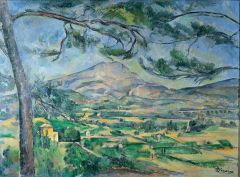
|
Cezanne
Mont Sainte-Victoire ca. 1887 Post-Impressionist Idea of 'passage' or blending of back- w/ foreground (Foliage of trees smeared w/ colors of mountain) Line of tree is parallel w/ mountain Interest in capturing effects of what we see |
|
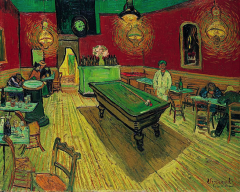
|
Vincent van Gogh
Night Cafe 1888 Post-Impressionist Exploration of ways color and distorted forms can express emotions Thickness, shape, direction of brushstrokes create tactile counterpart to intense colors Concerned w/ creating a mood (Expressionist) Calmness/quietness/despair vs. anxiety, over-stimulation |

